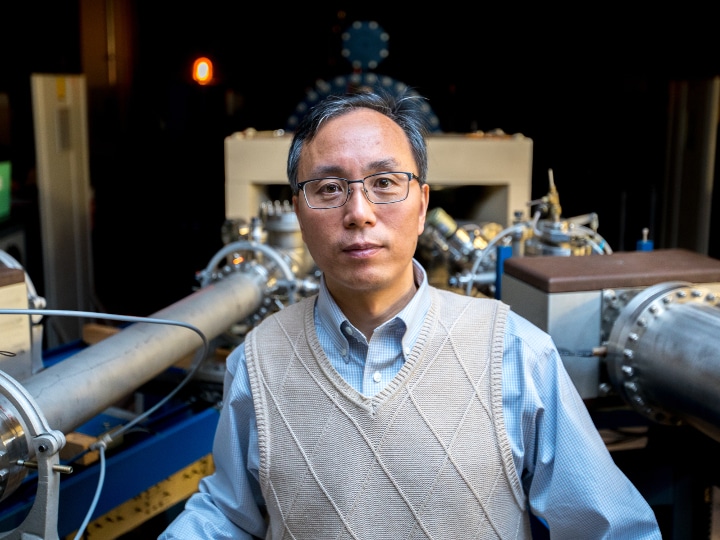Jun 25 2019
Three years ago, scientists gained attention when they reported that a two-dimensional (2D) perovskite – a material with a distinct crystal structure – made up of lead, cesium, and bromine produced an intense green light.
Crystals that create light on the green spectrum are desired because green light, while prized in itself, can also be comparatively easily converted to other forms that emit red or blue light, making it particularly important for optical applications spanning from light-emitting devices to sensitive diagnostic tools.
 Jiming Bao, associate professor of electrical and computer engineering, led an international group of researchers investigating how a two-dimensional perovskite composed of cesium, lead and bromine was able to emit a strong green light. (Image credit: University of Houston)
Jiming Bao, associate professor of electrical and computer engineering, led an international group of researchers investigating how a two-dimensional perovskite composed of cesium, lead and bromine was able to emit a strong green light. (Image credit: University of Houston)
But there was no consensus regarding how the crystal, CsPB2Br5, emitted the green photoluminescence. A number of theories emerged, without a conclusive answer.
Presently, however, scientists from the United States, Mexico, and China, led by an electrical engineer from the University of Houston, have stated in the journal Advanced Materials they have used high-tech optical and high-pressure diamond anvil cell methods to establish not only the mechanism for the light emission but also how to reproduce it.
They primarily synthesized CsPB2Br5 from an interrelated material called CsPbBr3 and learned that the real reason behind the light emission is a small overgrowth of nanocrystals made up of that original material, growing along the edge of the CsPB2Br5 crystals. While CsPbBr3, the base crystal, is 3D and appears green under UV light, the new material, CsPB2Br5, consists of a layered structure and is optically inactive.
Now that the mechanism for emitting this light is understood, it can be replicated,” “Both crystals have the same chemical composition, much like diamond versus graphite, but they have very different optical and electronic properties. People will be able to integrate the two materials to make better devices.
Jiming Bao, Associate Professor of Electrical and Computer Engineering, UH
Probable applications range from LED lighting to solar cells and other electronic devices. Bao, who was the corresponding author on the paper, started working on the issue in 2016, a project that eventually involved 19 scientists from UH and institutions in China and Mexico. During that time, there were two schools of scientific thought on the light emission from the cesium crystal: that it produced green light because of a defect, mostly a lack of bromine, instead of the material itself, or that a difference had accidentally been introduced, resulting in the production.
His team began with the synthesis of a pure sample by putting CsPbBr3 powder in water, resulting in crystals with sharper edges. The sharper edges produced a stronger green light, Bao said.
The scientists then used an optical microscope to explore the separate crystals of the compound, which Bao said enabled them to establish that although the compound is transparent, “something was going on at the edge, resulting in the photoluminescence.”
They depend on Raman spectroscopy – an optical method that uses information about how light interacts with a material to establish the material’s lattice properties – to detect nanocrystals of the original source material, CsPbBr3, along the sides of the crystal as the source of the light.
Bao said CsPbBr3 is too unsteady to use on its own, but the steadiness of the converted form is not obstructed by the small quantity of the original crystal.
The scientists said the new insight into the light emission will yield new openings to design and fabricate unique optoelectronic devices. The methods used to gain insight about the cesium-lead-halide compound can also be used for other optical materials to learn more about how they produce light, Bao said.
Besides Bao, scientists who took part in the project include: Chong Wang, Yanan Wang, Xinghua Su, Shengyu Dai, Zhaojun Qin, Francisco C. Robles-Hernandez and Yan Yao, all from the Department of Electrical and Computer Engineering at UH; Viktor G. Hadjiev of the Department of Mechanical Engineering at UH; Yizhou Ni and Shuo Chen of the UH Department of Physics; Md. Kamrul Alam of the materials science and engineering program at UH; Zhiming Wang of the University of Electronic Science and Technology of China; Guoying Feng of Sichuan University; Hector A. Calderon Benevides of the Instituto Politecnico Nacional; Haiyan Wang, Jie Jian and Qiang Li of Purdue University; and Quinkai Yu of Texas State University.